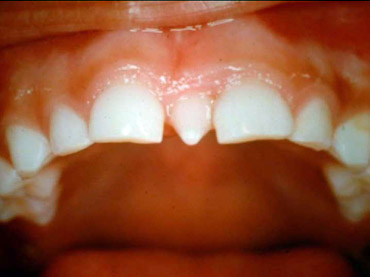As parents we are on constant alert when it comes to our child’s overall development. We may consciously or subconsciously compare our child to other children who are the same age. This occurs even when considering our child’s dental development. This article addresses several relatively common observations that parents have regarding their child’s overall dental development.
 My child’s permanent teeth are coming in before the primary teeth have fallen out. This situation is actually quite common, occurring in ~10% of children. One day a parent will look into their child’s mouth and see another row of teeth coming in behind the primary teeth. Normally, as the permanent teeth push up through the gums, the roots of the primary teeth are dissolved, causing them to fall out and make room for the erupting permanent tooth. Typically, this issue will be resolved all on its own with the primary teeth loosening and falling out. The permanent teeth will then slowly move forward into the space left by the primary teeth. This may happen fairly soon after the permanent teeth coming in, or it may take some time.
My child’s permanent teeth are coming in before the primary teeth have fallen out. This situation is actually quite common, occurring in ~10% of children. One day a parent will look into their child’s mouth and see another row of teeth coming in behind the primary teeth. Normally, as the permanent teeth push up through the gums, the roots of the primary teeth are dissolved, causing them to fall out and make room for the erupting permanent tooth. Typically, this issue will be resolved all on its own with the primary teeth loosening and falling out. The permanent teeth will then slowly move forward into the space left by the primary teeth. This may happen fairly soon after the permanent teeth coming in, or it may take some time.
 My child has an extra tooth. The extra primary tooth is called a supernumerary tooth. Children typically have 20 primary teeth, which are followed by 32 permanent teeth. Supernumerary primary teeth occur in ~3% of children. The occurrence of extra teeth can sometimes be associated with certain syndromes, but they can also occur in healthy children. The extra tooth may appear as a normal tooth, or it may be shaped differently. If the extra tooth has erupted abnormally or may prevent future permanent teeth from erupting, it may be best to remove the extra tooth. This condition is best evaluated by a pediatric dentist, as they can best advise if treatment is necessary.
My child has an extra tooth. The extra primary tooth is called a supernumerary tooth. Children typically have 20 primary teeth, which are followed by 32 permanent teeth. Supernumerary primary teeth occur in ~3% of children. The occurrence of extra teeth can sometimes be associated with certain syndromes, but they can also occur in healthy children. The extra tooth may appear as a normal tooth, or it may be shaped differently. If the extra tooth has erupted abnormally or may prevent future permanent teeth from erupting, it may be best to remove the extra tooth. This condition is best evaluated by a pediatric dentist, as they can best advise if treatment is necessary.
 My child is missing a tooth. There is a broad range of occurrence of missing teeth in children, depending on the tooth location. Permanent teeth are more commonly found to be missing than primary teeth. Absence of primary teeth occurs in <1% of the population, while absence of certain permanent teeth occurs in up to 20% of the population. When a primary tooth is missing, the permanent tooth behind it will also be missing. This condition can be genetically linked or may be associated with any number of syndromes. Treatment can vary depending on the individual situation. Orthodontics can be used to close gaps left by missing teeth. Also, bridges or implants can be used to fill the gaps when the patient reaches adulthood.
My child is missing a tooth. There is a broad range of occurrence of missing teeth in children, depending on the tooth location. Permanent teeth are more commonly found to be missing than primary teeth. Absence of primary teeth occurs in <1% of the population, while absence of certain permanent teeth occurs in up to 20% of the population. When a primary tooth is missing, the permanent tooth behind it will also be missing. This condition can be genetically linked or may be associated with any number of syndromes. Treatment can vary depending on the individual situation. Orthodontics can be used to close gaps left by missing teeth. Also, bridges or implants can be used to fill the gaps when the patient reaches adulthood.
The bottom line is that when you as a parent notice something out of the ordinary with your child’s teeth, don’t panic. Take the time to address your concerns with a pediatric dentist and go from there!
